The Intel Haswell-E CPU Review: Core i7-5960X, i7-5930K and i7-5820K Tested
by Ian Cutress on August 29, 2014 12:00 PM ESTEvolution in Performance
The underlying architecture in Haswell-E is not anything new. Haswell desktop processors were first released in July 2013 to replace Ivy Bridge, and at the time we stated an expected 3-17% increase, especially in floating point heavy benchmarks. Users moving from Sandy Bridge should expect a ~20% increase all around, with Nehalem users in the 40% range. Due to the extreme systems only needing more cores, we could assume that the suggested recommendations for Haswell-E over IVB-E and the others were similar but we tested afresh for this review in order to test those assumptions.
For our test, we took our previous CPU review samples from as far back as Nehalem. This means the i7-990X, i7-3960X, i7-4960X and the Haswell-E i7-5960X.
Each of the processors were set to 3.2 GHz on all the cores, and set to four cores without HyperThreading enabled.
Memory was set to the CPU supported frequency at JEDEC settings, meaning that if there should Intel have significantly adjusted the performance between the memory controllers of these platforms, this would show as well. For detailed explanations of these tests, refer to our main results section in this review.
Average results show an average 17% jump from Nehalem to SNB-E, 7% for SNB-E to IVB-E, and a final 6% from IVB-E to Haswell-E. This makes for a 31% (rounded) overall stretch in three generations.
Web benchmarks have to struggle with the domain and HTML 5 offers some way to help use as many cores in the system as possible. The biggest jump was in SunSpider, although overall there is a 34% jump from Nehalem to Haswell-E here. This is split by 14% Nehalem to SNB-E, 6% SNB-E to IVB-E and 12% from IVB-E to Haswell-E.
Purchasing managers often look to the PCMark and SYSmark data to clarify decisions and the important number here is that Haswell-E took a 7% average jump in scores over Ivy Bridge-E. This translates to a 24% jump since Nehalem.
Some of the more common synthetic benchmarks in multithreaded mode showed an average 8% jump from Ivy Bridge-E, with a 29% jump overall. Nehalem to Sandy Bridge-E was a bigger single jump, giving 14% average.
In the single threaded tests, a smaller overall 23% improvement was seen from the i7-990X, with 6% in this final generation.
The take home message, if there was one, from these results is that:
Haswell-E has an 8% improvement in performance over Ivy Bridge-E clock for clock for pure CPU based workloads.
This also means an overall 13% jump from Sandy Bridge-E to Haswell-E.
From Nehalem, we have a total 28% raise in clock-for-clock performance.
Looking at gaming workloads, the difference shrinks. Unfortunately our Nehalem system decided to stop working while taking this data, but we can still see some generational improvements. First up, a GTX 770 at 1080p Max settings:
The only title that gets much improvement is F1 2013 which uses the EGO engine and is most amenable to better hardware under the hood. The rise in minimum frame rates is quite impressive.
For SLI performance:
All of our titles except Tomb Raider get at least a small improvement in our clock-for-clock testing with this time Bioshock also getting in on the action in both average and minimum frame rates.
If we were to go on clock-for-clock testing alone, these numbers do not particularly show a benefit from upgrading from a Sandy Bridge system, except in F1 2013. However our numbers later in the review for stock and overclocked speeds might change that.
Memory Latency and CPU Architecture
Haswell is a tock, meaning the second crack at 22nm. Anand went for a deep dive into the details previously, but in brief Haswell bought better branch prediction, two new execution ports and increased buffers to feed an increased parallel set of execution resources. Haswell adds support for AVX2 which includes an FMA operation to increase floating point performance. As a result, Intel doubled the L1 cache bandwidth. While TSX was part of the instruction set as well, this has since been disabled due to a fundamental silicon flaw and will not be fixed in this generation.
The increase in L3 cache sizes for the highest CPU comes from an increased core count, extending the lower latency portion of the L3 to larger data accesses. The move to DDR4 2133 C15 would seem to have latency benefits over previous DDR3-1866 and DDR3-1600 implementations as well.


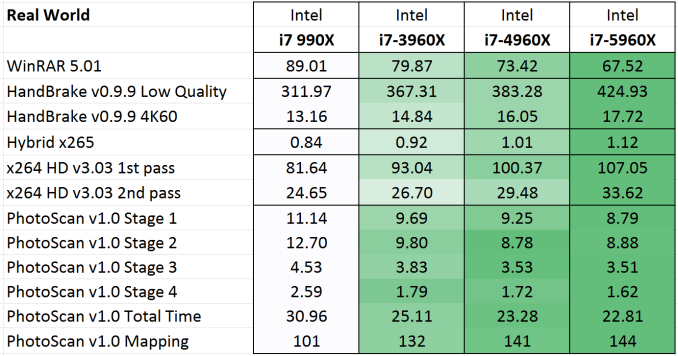


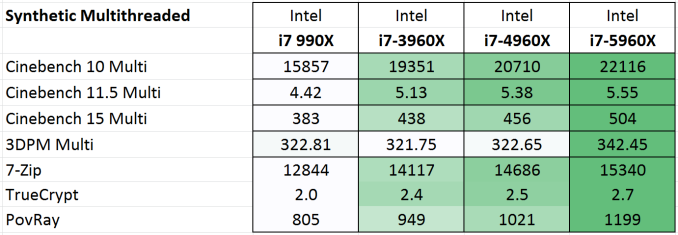

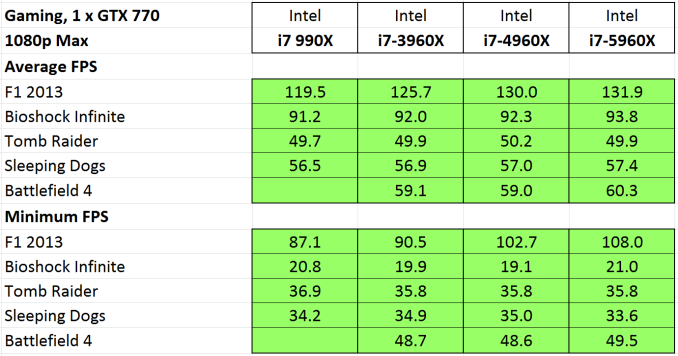
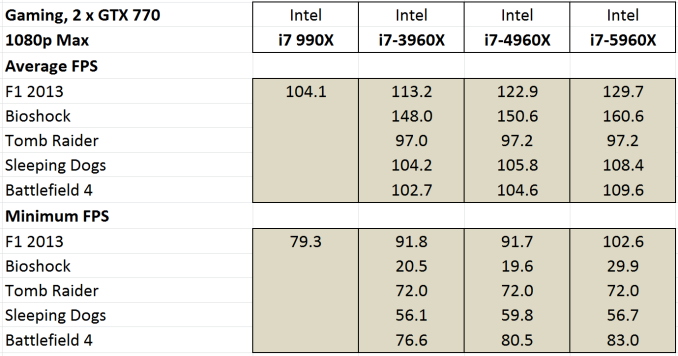
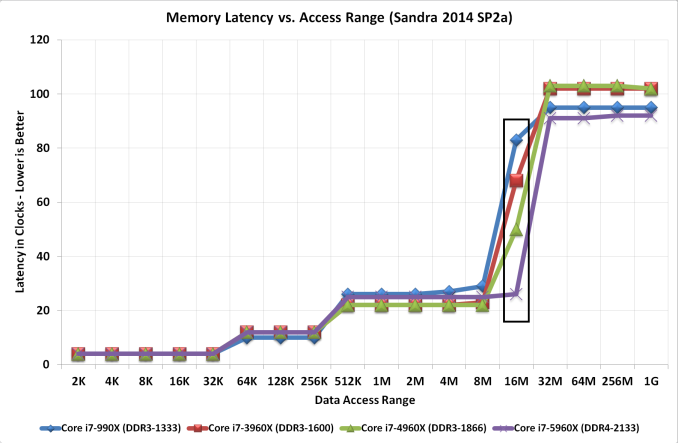








203 Comments
View All Comments
akLuckyCharm - Saturday, August 30, 2014 - link
Thank you Anand Tech for showing performance with ALL of the cpus overclocked as apposed to only one chip overclocked and the rest at stock. This makes the comparison much more fair and realistic.MrSpadge - Saturday, August 30, 2014 - link
I really like the analysis of performance per clock. It really helps me to judge CPU performance. However, why do you disable HT for these tests? All the CPUs considered have it, and on average it boosts performance. And most importantly:"Haswell bought... two new execution ports and increased buffers to feed an increased parallel set of execution resources... Intel doubled the L1 cache bandwidth."
Right. Which means Haswell may very well see better performance improvements from enabling HT than older CPUs. This could be very relevant for the workloads which people should run on these 6 and 8 core monsters. And by that I'm not talking about gaming ;)
vision33r - Sunday, August 31, 2014 - link
Most people don't need this setup because the only thing here is really your Haswell processor with couple of extra cores, a few different parts for DDR4, and a little bump here in L2 and that's it. Games don't need all of these changes because most games today are sophisticated enough to utilize them.I can certainly see that my VM and rendering machine will love the new 5960X and DDR4 but it's not worth investing in new platform when it just came out.
Anyone that does high end AV content creation will see a big bump if you got the money to spend on it.
HongKonger1997 - Sunday, August 31, 2014 - link
So if I only game with computer, my 3960X is still good?MrSpadge - Sunday, August 31, 2014 - link
Of course. Even a Sandy Bridge i5 would easily do the jpb, a 3960X is actually complete overkill.Artemis *Seven* - Sunday, August 31, 2014 - link
All great benchmarks except for the gaming ones. It's pretty common knowledge that Geforce cards like to handle almost everything "in-house" whereas AMDs tend to dump a big chunk of their workload onto the CPU. All I'm saying is that I'd love to see a gaming benchmark redone with R9's - I'm betting it would show the differences between these processors in games better - if there are actually any :Dmlambert890 - Monday, September 1, 2014 - link
the differences are minor with PURE cpu tests. sandy e to ivy e is about 5% ipc gain. ivy e to hw e is another 8% or so, but it suffers a 10% oc ceiling deficit against them and it has higher latency ram to boot.unless your workload truly has 8 threads or you multitask to the point you are saturating 6 fast cores this is a non upgrade coming from sandy or ivy
woj666 - Sunday, August 31, 2014 - link
It's curious why they used the dud 5960 results for overclocking vs the one that kept up to the 4790 in overclocking. I detect some 4 core bias here.A 5960@4.0 will run at the same temperature as a 4790@4.0.
mlambert890 - Monday, September 1, 2014 - link
double the active cores at same clock rate equals lots more power which equals lots more heat. notice the tdp values?faster - Sunday, August 31, 2014 - link
I might finally upgrade my work computer. I'm running an i7 920 with 8gb memory and a 256 GB SSD drive. I need that extra power for word processing, emailing, and surfing the web. Oh wait, no I don't. For the basic computer user, computers have been fast enough for many years.For my home gaming machine, I don't see a reason to upgrade my 4770k.